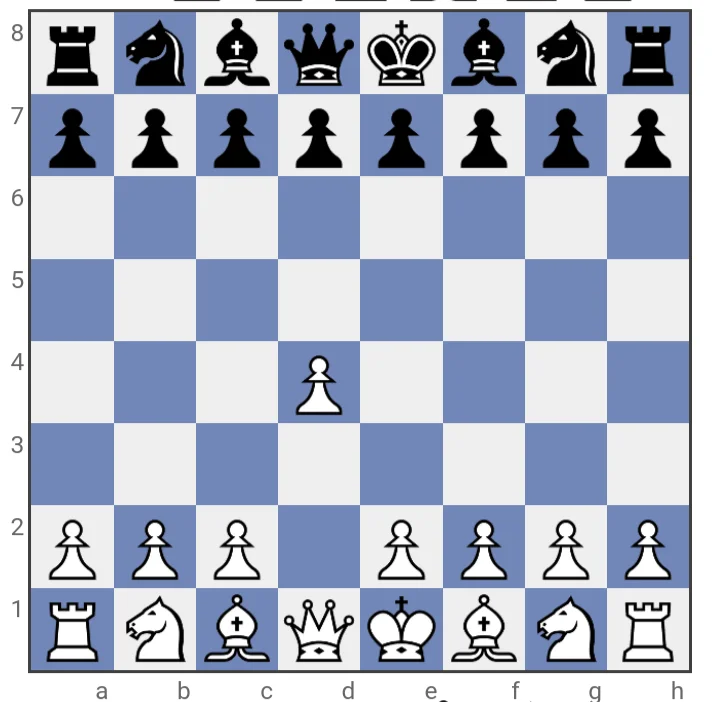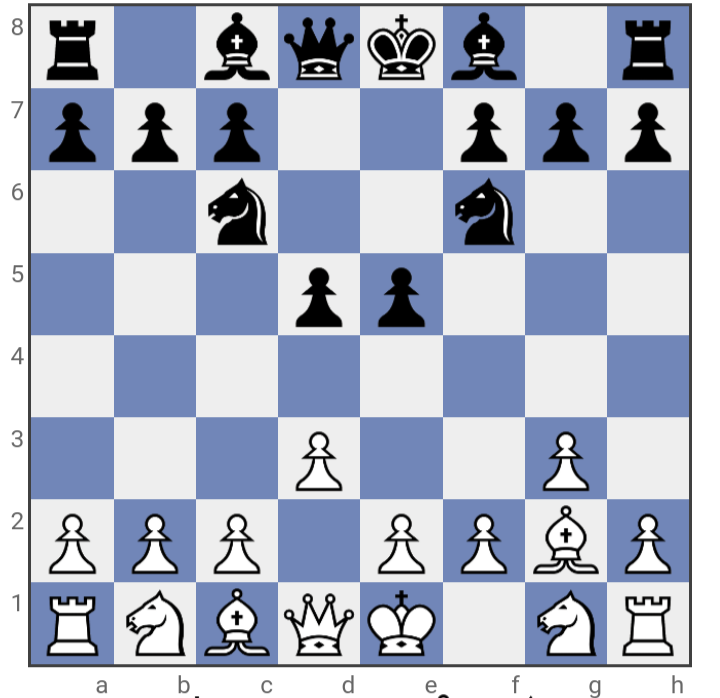Opening moves set the stage for the entire game. I’m Daniel, and I’m excited to share my passion for chess with you. In the late 1980s through the early ’90s, I spent countless hours playing chess at Washington Square Park in New York City. It was there that I honed my skills, faced off against formidable opponents, and truly fell in love with the game. I was also a proud member of the historic Marshall Chess Club, where I had the privilege of meeting quite a number of famous players who inspired and challenged me.
In this article, we will explore the best opening moves for White, emphasizing central control, piece development, Pawn structure, and King safety.
This post contains affiliate links. Please read our disclosure.
The King’s Pawn Opening (1.e4)
The King’s Pawn Opening, 1. e4, is one of the most classical and popular choices for White’s first move in chess. Its primary aim is to assert control over the central d5 square and facilitate rapid piece development. Is the position after White moves Pawn to e4.
By moving the Pawn to e4, White immediately stakes a claim in the center of the board. This move directly influences the central squares, d4 and d5, and paves the way for the development of the kingside pieces. 1. e4 has been a favorite of many grandmasters and world champions throughout chess history.
One of the key advantages of 1. e4 is its versatility. It sets the stage for a wide array of openings, each with its unique characteristics. For instance, after 1. e4 e5, we enter the realm of open games, characterized by free Pawn movement and open lines for rapid piece development. The Ruy Lopez and Italian Game are examples of classic openings that often arise from this position.
However, 1. e4 can also lead to the Sicilian Defense (1. e4 c5), which results in a rich and complex struggle where both sides aim for central control and active piece play. These diverse possibilities make 1.e4 a fantastic choice for players who enjoy dynamic, tactical positions and are well-prepared for various responses.
The Queen’s Pawn Opening (1. d4)
1. d4 is another highly regarded opening move for White, focusing on central control in a slightly different way. By advancing the d4 Pawn, White lays claim to the d5 square and prepares for controlled, strategic battles.
The following is the position after white has moved its Queen’s Pawn two spaces ahead:

The Queen’s Pawn Opening can lead to openings such as the Queen’s Gambit, King’s Indian Defense, and the Nimzo-Indian Defense. Each of these openings emphasizes different aspects of the game, from Pawn structure to piece activity.
One hallmark of the Queen’s Gambit is its willingness to offer a Pawn on d4, inviting Black to capture and enter into positions where central control and piece activity take center stage. On the other hand, the King’s Indian Defense focuses on dynamic Pawn structures and the kingside attack, while the Nimzo-Indian Defense is known for its solid and strategic character.
Choosing 1. d4 can lead to slower, more strategic games compared to 1. e4, and it often results in rich middlegame positions where Pawn structures play a crucial role. It’s an excellent choice for players who enjoy carefully planned attacks and positional chess.
Fianchetto Openings (King’s and Queen’s Side)
In chess, fianchetto is a strategic Pawn structure where a Pawn is moved one square forward, and then the Bishop is developed to the second rank behind it, typically on the g2 (for White) or g7 (for Black) square. This setup provides the Bishop with a long diagonal to control the board and is often used to support the center and prepare for kingside castling. Fianchettoed Bishops are known for their influence over the board from a distance.
In kingside fianchetto positions, such as 1. g3 (the King’s Fianchetto), the Bishop on g2 exerts control over the long diagonal from a1 to h8. This diagonal control can lead to powerful attacks and effective central influence.
On the Queen’s side, 1. b3 (the Queen’s Fianchetto) followed by Bb2 has a similar idea, providing support for central control and potential queenside operations.
In the following position, you can see how white has fianchettoed their Bishop on the King’s side:

Fianchettoed Bishops are known for their flexibility and long-range power. They are valuable assets in the opening, supporting central control and contributing to kingside or queenside safety.
Knight’s Openings (King’s and Queen’s Side)
Knight’s openings, such as 1. Nf3 (the Reti Opening) and 1. Nc3 (the Dunst Opening), focus on central control and rapid piece development. These openings are known for their flexibility and adaptability to various positions.
By developing the Knight to f3 or c3, White prepares to control key central squares and facilitate the kingside or queenside piece development. These openings can lead to a wide range of positions, from quiet, positional struggles to sharp, tactical battles, depending on the subsequent moves.
For instance, after 1. Nf3 d5, we might transpose into openings like the King’s Indian Defense or the Grünfeld Defense, both of which involve dynamic and rich middlegame positions. On the other hand, 1. Nc3 can lead to openings like the Nimzowitsch Defense or the Pirc Defense, where central control and piece activity are emphasized.
Other Opening Options
While we’ve discussed some of the best opening moves for White, it’s essential to acknowledge that chess offers a wide range of possibilities. Beyond 1. e4 and 1. d4, you can technically move any Pawn, although some choices are rarer than others.
Unconventional Pawn moves like 1. b4 (the Polish Opening) or 1. f3 (the Barnes Opening) are less common but can lead to unique positions. These moves often surprise opponents and take the game into uncharted territory. They should be approached with caution, as they can also weaken your Pawn structure or lead to unfamiliar positions.
Ultimately, while exploring lesser-known openings can be intriguing, it’s crucial to stay grounded in opening principles, such as central control, piece development, and King safety. Understanding these principles will serve you well regardless of your choice of opening move.
Other popular chess openings:
1. Ruy Lopez
2. Sicilian Defense
3. French Defense
4. Caro-Kann Defense
5. King’s Gambit
6. Slav Defense
7. Italian Game
8. Scotch Game
9. English Opening
10. Dutch Defense
What is the most popular opening in chess?
The Ruy Lopez, named after the 16th-century Spanish priest Ruy López de Segura, is considered one of the most enduring and respected openings in chess. Statistically, it is the most often played sequence. It is known for its rich history and deep strategic nuances. The opening unfolds as follows:
1. e4 e5
2. Nf3 Nc6
3. Bb5
White’s third move, Bb5, is the defining move of the Ruy Lopez. It serves multiple purposes. First and foremost, it pins Black’s Knight on c6 to the King on e8. This immediate threat can lead to various lines of play, ma King it a versatile choice for White. By applying pressure on Black’s position early on, White aims to gain a lead in piece development and central control.
The Ruy Lopez typically leads to open and dynamic positions, where both players have opportunities for active piece play and Pawn breaks. It often results in complex middlegame positions, requiring players to navigate carefully and strategically.
Some of the most well-known variations of the Ruy Lopez include the Closed Ruy Lopez, Open Ruy Lopez, and the Exchange Variation, each offering its unique set of ideas and plans. Players who favor the Ruy Lopez often appreciate the deep tactical and positional themes that arise, as well as the chance to engage in classical battles that have been studied and played by chess masters throughout history.
The Ruy Lopez is not only one of the most popular opening choices for White in chess, but it’s also a testament to the enduring appeal of classical chess principles, emphasizing control of the center, piece development, and strategic depth.
Improving Your Opening Moves as White
Mastering the opening moves as White in chess is essential for establishing a strong position and gaining an advantage in the early stages of the game. Here are some tips to help you become better at your opening moves:
- Study Opening Theory: Begin by familiarizing yourself with the fundamentals of various chess openings. Understand the goals, principles, and key moves for openings like the Ruy López, Sicilian Defense, and King’s Pawn Opening.
- Practice Regularly: Consistent practice is crucial for improvement. Play games, solve opening puzzles, and analyze your moves to identify weaknesses and areas for improvement.
- Focus on Development: Prioritize developing your pieces (Knights, Bishops, and queen) to active squares in the opening. Controlling the center of the board is essential for a strong start.
- Control the Center: Occupy and control central squares (d4, d5, e4, e5) with your Pawns and pieces. This restricts your opponent’s options and provides more mobility for your own forces.
- Avoid Early Mistakes: Be cautious about blunders and traps in the opening. Stay aware of common tactics like pins, forks, and skewers that can lead to early losses if not spotted.
- Learn from Masters: Study games played by chess masters in your chosen openings. Analyze their strategies and decisions to gain insights into successful opening play.
- Experiment and Adapt: Don’t be afraid to try different openings and adapt your repertoire based on your opponent’s responses. Flexibility is key to success.
- Use Chess Software: Utilize chess software and databases to explore opening variations, review your games, and identify areas where you can improve.
Becoming proficient in opening moves as White takes time and practice. As you develop your skills in this phase of the game, you’ll be better prepared for the middle game and endgame, increasing your chances of success in chess.
Conclusion
The opening moves in chess are the foundation upon which your game is built. Whether you prefer the central control and tactical possibilities of 1. e4, the strategic battles of 1. d4, the flexibility of Knight’s openings, or the unique character of unconventional moves, mastering the best opening moves for White is a journey worth undertaking.
As you explore these opening moves, remember that chess is not only a game but also a source of enrichment for the mind. It challenges you to think strategically, plan ahead, and make decisions under pressure. That’s why I believe that chess can help people become smarter and better businesspeople, as well as provide endless enjoyment and pleasure.
Resources for Further Learning
If you’re eager to dive deeper into the world of chess openings, here are some valuable resources to help you expand your knowledge and improve your game:
- Chess.com Openings Explorer – A comprehensive database of chess openings, including tutorials, statistics, and practice tools.
- Chessable – An interactive platform offering courses and drills to master various openings and chess tactics.
- 365Chess Opening Database – An extensive collection of opening moves, games, and analysis for in-depth study.
- New in Chess – Opening Guides – A series of books and eBooks dedicated to specific openings and their strategic nuances.
- Saint Louis Chess Club YouTube Channel – Features instructional videos, lectures, and game analysis by top chess grandmasters.
- r/chess on Reddit – A vibrant online community where you can discuss chess strategies, ask questions, and share your insights.
These resources offer a wealth of information, from tutorials and practice materials to forums for discussing your progress and get chess advice from fellow chess enthusiasts. Happy learning!




